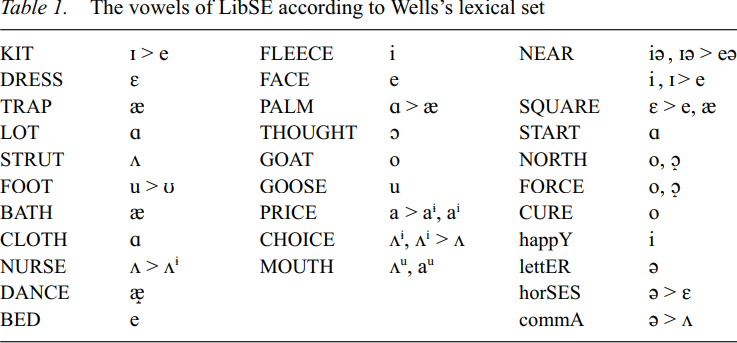
Phonetics and phonology Phonemic inventory Vowels
 المؤلف:
John Victor Singler
المؤلف:
John Victor Singler
 المصدر:
A Handbook Of Varieties Of English Phonology
المصدر:
A Handbook Of Varieties Of English Phonology
 الجزء والصفحة:
880-49
الجزء والصفحة:
880-49
 2024-05-13
2024-05-13
 1337
1337
Phonetics and phonology
Phonemic inventory
Vowels

(DANCE and BED are not part of the lexical set, but they have been included here to distinguish their vowels from those in TRAP and DRESS, respectively.(..
LibSE can be said to have ten or eleven monophthongs, depending on whether /Λ/ and /ə/ are considered to be distinct. While there is a contrast between high front vowels between /i/ and /ɪ/, there is no consistent corresponding contrast in the back. Instead, a word like foot is ordinarily realized as [fu] or [fut].
LibSE has five front vowels, illustrated by the minimal quintuple beat, bit, bait, bet, and bat. When occurring before a nasal consonant, the /æ/ and /ε/ are raised, but the contrast with other vowels is preserved. Before voiced stops, what was historically /ε/ has undergone raising to [e]. Thus, head is pronounced [he] or [hed]. The infrequency with which the following voiced stop is realized on the surface in such words has led to the re-analysis of American English bed when it has the meaning ‘an area of ground where flowers or plants are grown’ as LibSE bay.
Further acoustic work is needed to determine the basis of the following contrasts: /i/ vs. /ɪ/ , /e/ vs. /ε/, and /o/ vs. /ɔ/. The question is the extent to which the contrasts are based on differences in length, height, and/or peripherality. It is also possible that a tense/lax distinction forms the basis for the contrasts; if that is so, it would be necessary to address the relationship of the tense/lax distinction to the other distinctions, an ongoing issue in the study of English vowels. The American English generalization that lax vowels other than /ə/ can only occur in closed syllables does not hold on the surface in LibSE: [tε] is a common pronunciation of tell, and [sɪ] of sit. In the case of /e/ vs. /ε/ and /o/ vs. /ɔ/, there seems to be a clear height difference, with the first of the two vowels the higher of the two.
Diphthongs are frequently monophthongized, particularly the diphthong in PRICE. The diphthongs in PRICE and CHOICE are nearly homophonous, with the nucleus of the vowel in PRICE slightly lower than the nucleus of the vowel in CHOICE.
The greatest range of variation among speakers involves the vowels in NURSE, NEAR and SQUARE. In the case of NURSE, the nucleus tends to be mid and central, but there is variation both in height (from mid-low to mid-high) and backness (from central to somewhat front). For some speakers at least, the vowel sometimes ends with a high, central upglide. The vowel in NEAR is always front, but speakers vary not only in their realization of the vowel (i, I, or e) but also as to whether it is followed by /ə/. Thus, /i/, /iə/ , /ɪ/ , /ɪə/ , /e/, and /eə/ are all possible realizations.
The range and number of vowels in LibSE place it in contrast with VLE and with other Liberian languages. For most speakers of VLE, there is an eight-vowel system, a basic seven-vowel system plus /ə/. Most of Liberia’s Niger-Congo languages have the basic seven-vowel system, though Klao and Grebo have nine owing to an ATR contrast.
 الاكثر قراءة في Phonology
الاكثر قراءة في Phonology
 اخر الاخبار
اخر الاخبار
اخبار العتبة العباسية المقدسة


